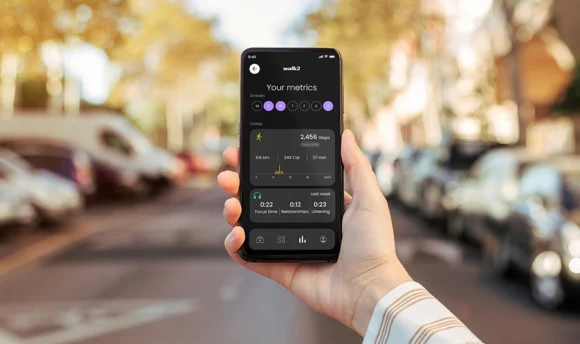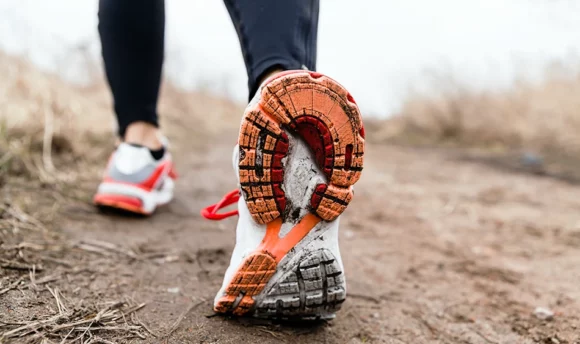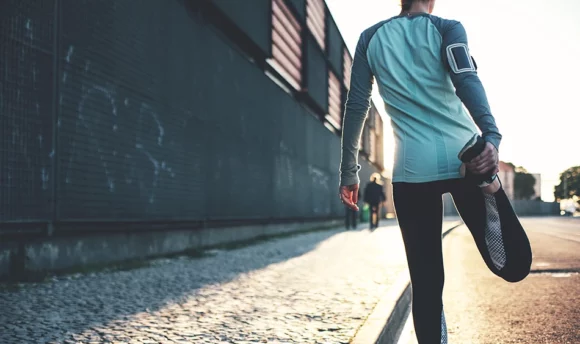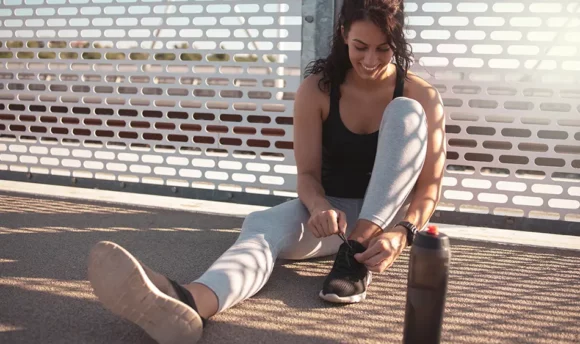Barefoot Running: Benefits, Side Effects, and Technique
Have you ever tried barefoot running? Discover the benefits and side effects of running naturally and how to get the technique right.
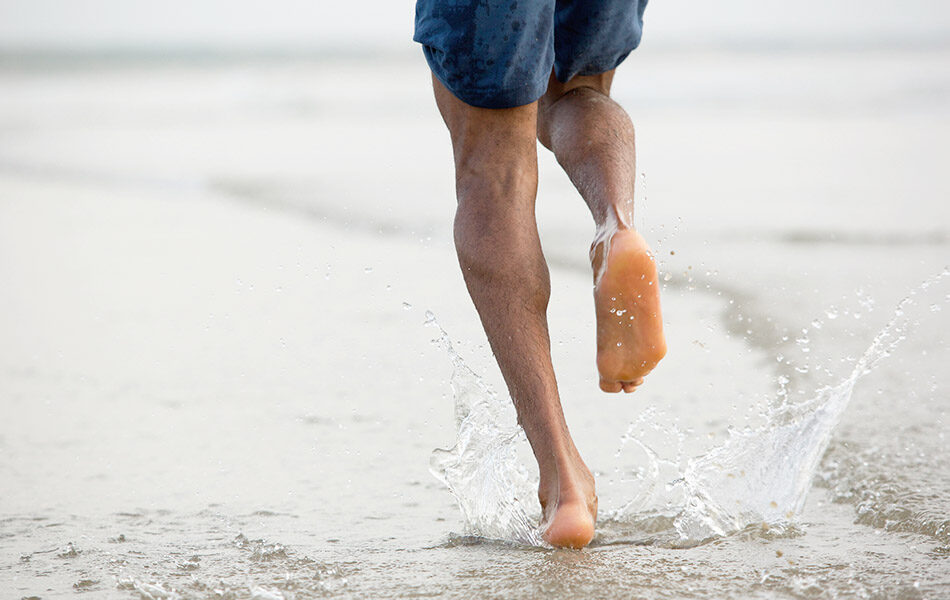
In 1960, Abede Bikila ran the Olympic marathon in Rome barefoot and won the gold medal. Inspired by this legendary race, many runners have tried barefoot running in the decades since.
Barefoot running can sound liberating. But is it safe not to wear shoes when going for a run? What are the effects on your joints, muscles, and tendons and do the advantages outweigh the risks?
Let’s find out!
Is Running Barefoot Good for You?
Running without shoes can improve your running technique and strengthen your leg muscles. It reduces heel striking and promotes an efficient forefoot strike.
But you can’t “run naturally” for as long or as hard as you can in cushioned shoes. The downside to running barefoot is that it increases your risk of running injuries, including minor punctures and scrapes, as well as serious overuse injuries.
The bottom line is that running with no shoes on is good if you start slow and do it in moderation on a surface that won’t injure your feet, like sand or grass. It’s also important to adapt your running plan accordingly.
5 Benefits of Running Barefoot
It’s not just about the contact of your feet with the ground or the sense of freedom that comes with not wearing running shoes.
From a better running technique to burning more calories, barefoot running brings some benefits you may not have considered.
#1 Improves your running technique
Barefoot running encourages you to run efficiently. Your strides become shorter and better aligned with your body’s center of gravity.
You will also land more on the ball of your foot. By reducing heel strike, you make your running movements more efficient and since you have no arch support, your foot muscles become stronger.
At the same time, you will be bending your knees more. This can make it easier for your joints to absorb the shock of the foot striking the ground.
The improvements in running technique that come with barefoot running can lead to a better running economy. If you are not comfortable with running barefoot, we would advise you to start with minimalist shoes.
Most minimalist shoes are thin-soled shoes that usually have stiff soles. Their rubber sole mimics the shape of the human foot and provides foot protection against hard surfaces without any cushioning.
Check out this video from the BBC Earth Lab to better understand how going natural changes the way you run:
#2 Strengthens tendons and reduces certain running injuries
As we’ve seen, barefoot running trains you to land on your forefoot instead of your heel. This change to heel striking can reduce running injuries associated with the plantar fascia, hamstring, and knee.
Barefoot running can make your foot tendons more elastic. A long-term benefit of this is a lower risk of tendinitis. Tendinitis is a common overuse injury in runners training for a marathon or other long-distance event.
For people with flat feet, running without shoes strengthens foot muscles that otherwise can remain underdeveloped if always supported by traditional running shoes.
#3 May improve sleep and relieve stress
Direct contact of the feet with the electrons on the surface of the earth could have multiple health benefits, including stress relief and better sleep, according to research.
Known as earthing or grounding, direct contact with the ground promotes the transfer of electrons from the earth into your body.
The negative charge of the Earth’s surface could help create a more stable internal bioelectrical environment. It may also regulate the secretion of hormones and, with it, the body’s diurnal rhythms.
#4 May give you a healthy dose of antioxidants
Research on grounding suggests that when you walk or run without wearing shoes, the electrons you get from the earth can act as antioxidants in the body.
Antioxidants protect your cells from free radicals and oxidative stress resulting from environmental pollution and natural cellular processes.
They also can help prevent a wide range of conditions, from eye diseases to cancer and may also slow down aging.
#5 Helps you burn more calories
When you run barefoot, you can’t count on your running shoes to give you a forward bounce. You can still run fast, but your run is going to be tougher.
Barefoot runners have more work to do, and that can make them burn more calories. If you want to maximize the calories you burn running, leaving your cushioned shoes at home can help.
What Are the Possible Downsides of Running Barefoot?
Before you ditch your old running shoes, here are some of the potential drawbacks of running in bare feet.
#1 Exposes feet to bacteria
Direct contact of your feet with the ground exposes them to bacteria and fungi that can cause foot infections.
A common example is an athlete’s foot. Usually beginning at the toes, this fungal skin infection causes scaly and peeling skin, itchy feet, skin inflammation, burning, blisters, and dry skin.
Even when the foot infection is not serious, it can still impair your ability to run.
#2 Possible foot injuries
Barefoot runners are at risk of suffering cuts, punctures, and other wounds that may become infected.
Barefoot running places more weight on the front part of your foot. At the same time, it stresses the Achilles tendon and the calf muscle.
A natural consequence of this is a higher risk of Achilles tendinitis, forefoot stress fractures, pulled calf muscles, and calf strains.
Running Barefoot Technique
The key to barefoot running is to develop a soft and fluid running technique. Avoid an aggressive heel strike or running with a foot strike pattern that makes your feet slap against the ground.
Run with a quiet footfall, focusing on a forefoot strike. By minimizing heel striking, you make your barefoot movement smoother and absorb shock better.
The result will be a better running technique that makes you a better runner, whether you go barefoot, wear minimalist shoes, or switch to cushioned shoes.
Tip: Improving your running technique becomes easier if you use a running app. Discover the best running apps for beginners now.
Other Tips for Starting Running Barefoot
Keen to run barefoot already? Many runners make the mistake of transitioning from wearing shoes to barefoot running too suddenly. The following tips and suggestions can help with injury prevention and maintaining foot health.
#1 Allow your feet to adapt to barefoot running
Some surfaces are harder than others. Compare a concrete pavement with a sandy beach or grassy path. Barefoot runners attempting to run on hard surfaces right away can easily damage their feet.
Start running on a softer surface like sand, grass, or rubberized track. As the skin of your feet becomes firmer, you can gradually transition to harder surfaces, including trails and concrete.
This adaptation doesn’t happen overnight. You’ll also have to put up with at least a few blisters until your skin hardens. You can also go from wearing running shoes to minimalist running shoes and only then start running without shoes.
Barefoot running shoes have no heel-to-toe drop, no arch support, and no thick heel cushioning. A good minimalist shoe with a thin and flexible sole and no heel-to-toe drop creates a barefoot-like experience while reducing the risk of injury.
Tip: Remember that running gear isn’t only about your shoes. Wear the right gear when you run, depending on the weather.
#2 Start small and progress slowly
If you switch to barefoot running, you may not be able to run as far or as fast as you could in cushioned shoes or even minimalist running shoes with no heel-to-toe drop.
Pushing yourself too hard in the beginning, can result in foot and muscle injuries. It may also take the fun out of running without shoes.
Follow a plan for barefoot runners that gradually ups the difficulty of your runs. That way, you’ll build endurance and steadily develop the correct running form for running with minimal footwear.
A safe approach is to start with only 10 minutes of barefoot running per run. Increase this by 5% from one week to the next.
#3 Care for your feet
Wash your feet thoroughly after each barefoot run. Clip your toenails and bandage any cuts. If the skin on your feet becomes dry and hard, apply a moisturizer.
Taking care of your feet also means giving them a break when they need it. If barefoot running is hard on your feet, wait at least a few days to let them recover before you go running.
FAQs
Running barefoot can make you a better forefoot runner and improve your running technique. But it increases the risk of overuse injuries, including stress fractures. Barefoot running is good only when done in moderation and on safe surfaces.
Going for a long run without shoes on can damage your foot. It can lead to foot pain, plantar fasciitis, Achilles tendonitis, metatarsal stress fractures, and calf strain. Minimize these risks by wearing minimalist footwear.
A Word From Our Coach
Running without shoes could increase your running economy (how much oxygen your body needs to run at a determined pace) by 1% for every 100-gram reduction in shoe weight.
If your running shoes weigh 300 grams, going barefoot can improve your running economy by 3%. At the same time, it will force you to pay attention to your running gait and running form.
But these benefits are counterbalanced by the higher stress that your feet have to endure and the higher risk of Achilles tendon inflammation and other injuries.
Adding barefoot running to your running plan can be beneficial. But switching completely from running in traditional running shoes to barefoot running isn’t feasible for most runners.
Start slow and wear barefoot or minimalist shoes. That way, you can improve your running technique without injuring your feet.
Key Takeaways
Planning on trying barefoot running soon? Here are the things you want to remember:
- Giving up on traditional running shoes and going barefoot won’t make you a better runner overnight.
- Natural running or running without shoes can help you improve your running style.
- Wear minimalist shoes to transition more easily from normal running to barefoot running.
- Features such as a heel-to-toe drop in barefoot shoes can improve your posture, running style and reduce stress on your joints.
- Running with no shoes won’t be liberating if you puncture or injure your feet, so choose your running trail with care and start slow.

















































 Select your language:
Select your language: 





